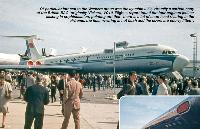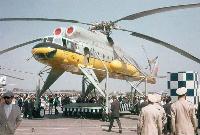Фотографии
-
Самолёты на фотографии: Антонов Ан-22 Антей - Россия - 1965
-
Самолёты на фотографии: Антонов Ан-22 Антей - Россия - 1965
-
Регистрационный номер: СССР-06176 [3] 50 years ago the Soviet Union brought its state-of-the-art airliners to the Paris Air Salon, including the Il-62 and An-22.
Самолёты на фотографии: Антонов Ан-22 Антей - Россия - 1965Ильюшин Ил-62 - Россия - 1963
-
Регистрационный номер: СССР-46191 Big. But not as big as a Brabazon. Such was the rather peevish reaction of the British aviation press to the An-22 at Paris. It was nevertheless a remarkable sight on its arrival and one that could hardly fail to impress, with its 211ft 4in (64-4m) wingspan and four 15,000 s.h.p. Kuznetsov NK-12MA turboprops, each driving a contra-rotating pair of four-bladed propellers.
Самолёты на фотографии: Антонов Ан-22 Антей - Россия - 1965
-
Регистрационный номер: СССР-75581 An exceptionally modern aircraft by contemporary standards, the Ilyushin Il-18 turboprop was designed for international and domestic routes. The prototype, named Moskva, first flew in July 1957 and the type had entered Aeroflot service by the spring of 1959. This example, CCCP-75581, was the first long-range Il-18D.
Самолёты на фотографии: Ильюшин Ил-18 - Россия - 1957
-
Регистрационный номер: СССР-06174 In 1965 the Mil Mi-6 was still the largest helicopter flying anywhere in the world, despite appearing to be smaller than the Mi-10, itself a development of the Mi-6. Since its first flight in 1957 the Mi-6 had set numerous helicopter world records for speed and payload-to-height. Note the stub-wing fitted to unload the rotor in flight.
Самолёты на фотографии: Миль Ми-6 - Россия - 1957
-
Регистрационный номер: СССР-06181 Fitted with attractive wheel fairings and in a stylish white, grey-blue and red colour scheme, the Mil Mi-8 made a positive impression on the Western press, Flight noting that this was “a modern and handsome replacement for the Mi-4” which ‘‘gave a very comfortable ride”.
Самолёты на фотографии: Миль Ми-8 / Ми-8Т - Россия - 1962
-
Регистрационный номер: СССР-06176 [3] Of particular interest to the Western press was the Ilyushin Il-62, virtually a carbon-copy of the British BAC (originally Vickers) VC10. Flight’s report found the four-engined jetliner lacking in sophistication, pointing out that “there is a lot of snap-head riveting in the airframe, the flush-riveting is not flush and the doors are poorly fitted”.
Самолёты на фотографии: Ильюшин Ил-62 - Россия - 1963
-
Регистрационный номер: СССР-06176 [3] The Il-62’s wing incorporated a “dog-tooth” contour and various twists to improve the four-engined jetliner’s stall characteristics after initial problems with its low-speed behaviour.
Самолёты на фотографии: Ильюшин Ил-62 - Россия - 1963
-
Регистрационный номер: СССР-45076 The second prototype Tupolev Tu-134, CCCP-45076, took pride of place at Paris as the Soviet Union’s latest short-haul twin-engined jetliner. It was to survive only another seven months, however, crashing on January 14, 1966, during one of its many test flights, when the rudder was over-extended, putting the airliner into a dive.
Самолёты на фотографии: Туполев Ту-134 - Россия - 1962
-
Регистрационный номер: СССР-46791 Nestling between the Soviet jet hardware at Paris, the Antonov An-24 was open to inspection by the press and public. Similar in configuration and size to the West’s extremely successful Fokker F-27 Friendship, the turboprop-powered An-24 (Nato codename Cokej was designed to operate from unpaved airfields of limited size.
Самолёты на фотографии: Антонов Ан-24 - Россия - 1960
-
Регистрационный номер: СССР-11359 Looking handsome in its Aeroflot scheme, the Antonov An-12 was one of the three Soviet transports that participated in the flying display at Paris. The other two were the An-24 and the Tu-134, along with the Mi-6, Mi-8 and Mi-10 helicopters.
Самолёты на фотографии: Антонов Ан-12 - Россия - 1957
-
Essentially a scaled-down Tu-104, the Tu-124 was designed to a 1957 specification for a jet-powered replacement for the Ilyushin Il-14 piston-engined short-hauler on domestic routes. The prototype made its maiden flight in March 1960 and the Cookpot, as it was designated by Nato, began Aeroflot services in October 1962.
Самолёты на фотографии: Туполев Ту-124 - Россия - 1960
-
Регистрационный номер: СССР-04102 Anything you can do... we can do bigger! Mil Mi-10 CCCP-04102 was by far the most unusual and impressive helicopter at the 1965 Paris show, startling spectators with its distinctive long-stroke quadricycle undercarriage of 19ft 8in (6m) track, which separated the fuselage from the ground by some 12ft 3!6in (3 75m).
Самолёты на фотографии: Миль Ми-10 - Россия - 1960
-
The shapely V-tailed Antonov A-15 glider at Paris before the morning removal of its protective tarpaulin. The aluminium glider made its first flight in March 1960 and quickly set a number of world records. Some 350 examples were ultimately built.
Самолёты на фотографии: Антонов А-11 / А-13 / А-15 - Россия - 1957
Статьи
- -
- B.Livingstone - Vis - the Allies' Adriatic Eyrie
- D.Lockspeiser - Our Main in the Middle East
- D.Nijboer - Square Peg ... Round Hole
- D.Stern - Sub-zero Inc.
- E.Young - Over the Weather
- F.Merriam - Halford saves the Day /Echoes from Dawn Skies/ (7)
- I.Bott, N.Fraser - Lockheed's Fading Suntan
- J.Forsgren - Sweden's Forgotten Designer
- J.Franzi - Their Work is Done! /An eye for detail/
- J.Stroud - Over the Pass and Down the Valley... /The John Stroud Archive/
- M.Willis - From Swordfish to Firefly /Duncan Menzies/ (2)
- P.Davidson - Off the Beaten Track...
- P.Jarrett - Lost & Found
- T.Newdick - A Paris avec les Soviets
- W.Thompson - The Scarface Klan














